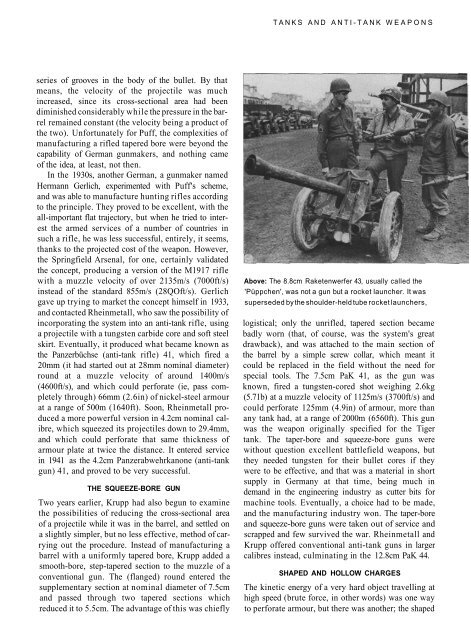Submarines and their Weapons - Aircraft of World War II
Submarines and their Weapons - Aircraft of World War II
Submarines and their Weapons - Aircraft of World War II
Create successful ePaper yourself
Turn your PDF publications into a flip-book with our unique Google optimized e-Paper software.
series <strong>of</strong> grooves in the body <strong>of</strong> the bullet. By that<br />
means, the velocity <strong>of</strong> the projectile was much<br />
increased, since its cross-sectional area had been<br />
diminished considerably while the pressure in the barrel<br />
remained constant (the velocity being a product <strong>of</strong><br />
the two). Unfortunately for Puff, the complexities <strong>of</strong><br />
manufacturing a rifled tapered bore were beyond the<br />
capability <strong>of</strong> German gunmakers, <strong>and</strong> nothing came<br />
<strong>of</strong> the idea, at least, not then.<br />
In the 1930s, another German, a gunmaker named<br />
Hermann Gerlich, experimented with Puff's scheme,<br />
<strong>and</strong> was able to manufacture hunting rifles according<br />
to the principle. They proved to be excellent, with the<br />
all-important flat trajectory, but when he tried to interest<br />
the armed services <strong>of</strong> a number <strong>of</strong> countries in<br />
such a rifle, he was less successful, entirely, it seems,<br />
thanks to the projected cost <strong>of</strong> the weapon. However,<br />
the Springfield Arsenal, for one, certainly validated<br />
the concept, producing a version <strong>of</strong> the M1917 rifle<br />
with a muzzle velocity <strong>of</strong> over 2135m/s (7000ft/s)<br />
instead <strong>of</strong> the st<strong>and</strong>ard 855m/s (28QOft/s). Gerlich<br />
gave up trying to market the concept himself in 1933,<br />
<strong>and</strong> contacted Rheinmetall, who saw the possibility <strong>of</strong><br />
incorporating the system into an anti-tank rifle, using<br />
a projectile with a tungsten carbide core <strong>and</strong> s<strong>of</strong>t steel<br />
skirt. Eventually, it produced what became known as<br />
the Panzerbüchse (anti-tank rifle) 41, which fired a<br />
20mm (it had started out at 28mm nominal diameter)<br />
round at a muzzle velocity <strong>of</strong> around 1400m/s<br />
(4600ft/s), <strong>and</strong> which could perforate (ie, pass completely<br />
through) 66mm (2.6in) <strong>of</strong> nickel-steel armour<br />
at a range <strong>of</strong> 500m (1640ft). Soon, Rheinmetall produced<br />
a more powerful version in 4.2cm nominal calibre,<br />
which squeezed its projectiles down to 29.4mm,<br />
<strong>and</strong> which could perforate that same thickness <strong>of</strong><br />
armour plate at twice the distance. It entered service<br />
in 1941 as the 4.2cm Panzerabwehrkanone (anti-tank<br />
gun) 41, <strong>and</strong> proved to be very successful.<br />
THE SQUEEZE-BORE GUN<br />
Two years earlier, Krupp had also begun to examine<br />
the possibilities <strong>of</strong> reducing the cross-sectional area<br />
<strong>of</strong> a projectile while it was in the barrel, <strong>and</strong> settled on<br />
a slightly simpler, but no less effective, method <strong>of</strong> carrying<br />
out the procedure. Instead <strong>of</strong> manufacturing a<br />
barrel with a uniformly tapered bore, Krupp added a<br />
smooth-bore, step-tapered section to the muzzle <strong>of</strong> a<br />
conventional gun. The (flanged) round entered the<br />
supplementary section at nominal diameter <strong>of</strong> 7.5cm<br />
<strong>and</strong> passed through two tapered sections which<br />
reduced it to 5.5cm. The advantage <strong>of</strong> this was chiefly<br />
TANKS AND ANTI-TANK WEAPONS<br />
Above: The 8.8cm Raketenwerfer 43, usually called the<br />
'Püppchen', was not a gun but a rocket launcher. It was<br />
superseded by the shoulder-held tube rocket launchers,<br />
logistical; only the unrifled, tapered section became<br />
badly worn (that, <strong>of</strong> course, was the system's great<br />
drawback), <strong>and</strong> was attached to the main section <strong>of</strong><br />
the barrel by a simple screw collar, which meant it<br />
could be replaced in the field without the need for<br />
special tools. The 7.5cm PaK 41, as the gun was<br />
known, fired a tungsten-cored shot weighing 2.6kg<br />
(5.71b) at a muzzle velocity <strong>of</strong> 1125m/s (3700ft/s) <strong>and</strong><br />
could perforate 125mm (4.9in) <strong>of</strong> armour, more than<br />
any tank had, at a range <strong>of</strong> 2000m (6560ft). This gun<br />
was the weapon originally specified for the Tiger<br />
tank. The taper-bore <strong>and</strong> squeeze-bore guns were<br />
without question excellent battlefield weapons, but<br />
they needed tungsten for <strong>their</strong> bullet cores if they<br />
were to be effective, <strong>and</strong> that was a material in short<br />
supply in Germany at that time, being much in<br />
dem<strong>and</strong> in the engineering industry as cutter bits for<br />
machine tools. Eventually, a choice had to be made,<br />
<strong>and</strong> the manufacturing industry won. The taper-bore<br />
<strong>and</strong> squeeze-bore guns were taken out <strong>of</strong> service <strong>and</strong><br />
scrapped <strong>and</strong> few survived the war. Rheinmetall <strong>and</strong><br />
Krupp <strong>of</strong>fered conventional anti-tank guns in larger<br />
calibres instead, culminating in the 12.8cm PaK 44.<br />
SHAPED AND HOLLOW CHARGES<br />
The kinetic energy <strong>of</strong> a very hard object travelling at<br />
high speed (brute force, in other words) was one way<br />
to perforate armour, but there was another; the shaped


